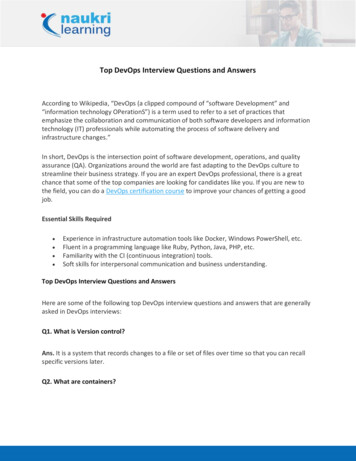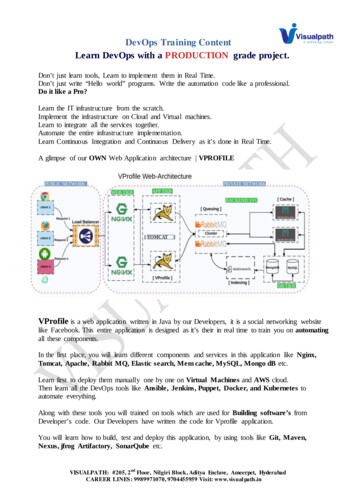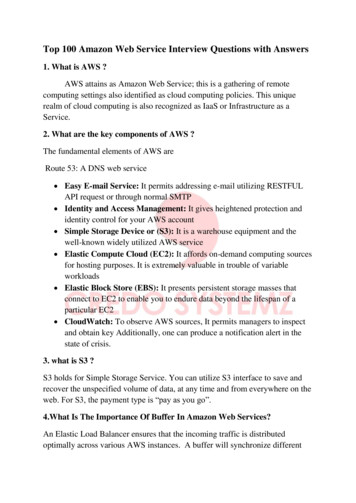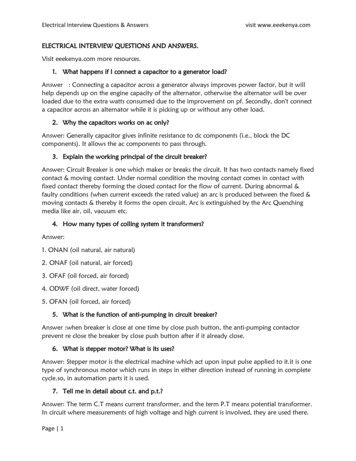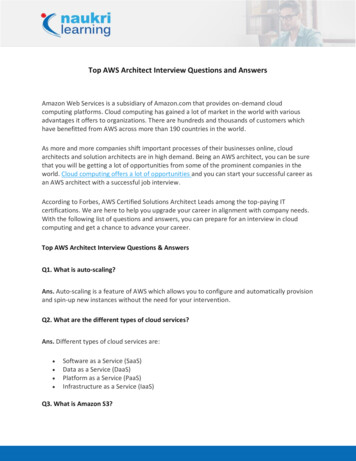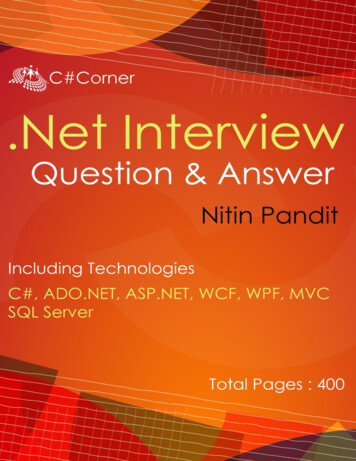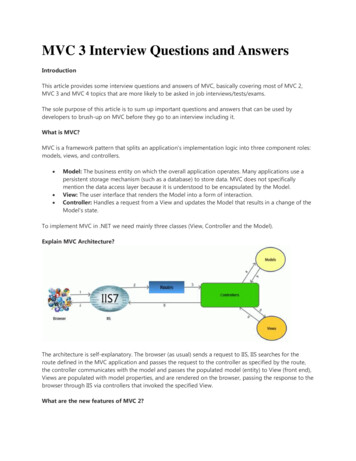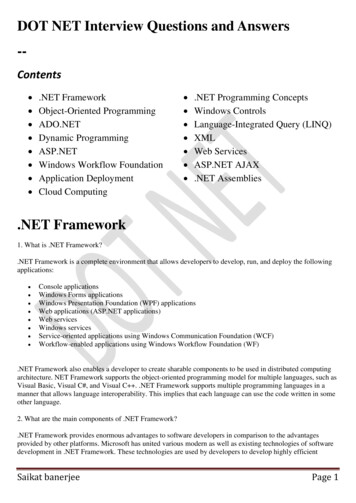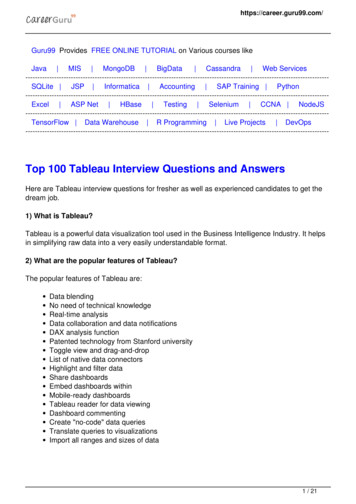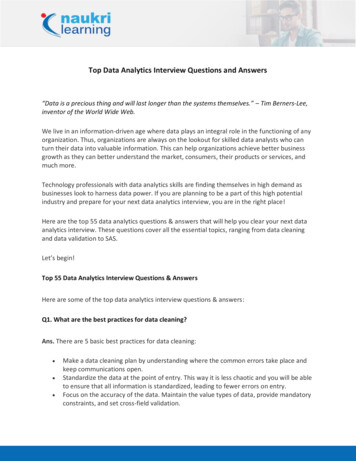
Transcription
DevOps Interview ons/DevOpsDevOps Interview Questions, From beginner to expert level DevOps Professional. Thesequestions covers a wide range of topics any DevOps professional needed to know to nailan interview.Table of Contents:CHAPTER 1: DevOps IntroductionCHAPTER 2: Gradle Interview QuestionsCHAPTER 3: Groovy Interview QuestionsCHAPTER 4: Maven Interview QuestionsCHAPTER 5: Linux Interview Questions1/71
CHAPTER 6: GIT Interview QuestionsCHAPTER 7: Continuous Integration Interview QuestionsCHAPTER 8: Amazon AWS Interview QuestionsCHAPTER 9: Splunk Interview QuestionsCHAPTER 10: Log4J Interview QuestionsCHAPTER 11: Docker Interview QuestionsCHAPTER 12: VmWare Interview QuestionsCHAPTER 13: DevOps Security Interview QuestionsCHAPTER 14: DevOps Testing Interview QuestionsCHAPTER 15: SummaryCHAPTER 16: DevOps Interview Questions PDFQuestion: What Are Benefits Of DevOps?DevOps is gaining more popularity day by day. Here are some benefits of implementingDevOps Practice.Release Velocity: DevOps enable organizations to achieve a great release velocity. Wecan release code to production more often and without any hectic problems.Development Cycle: DevOps shortens the development cycle from initial design toproduction.Full Automation: DevOps helps to achieve full automation from testing, to build, releaseand deployment.Deployment Rollback: In DevOps, we plan for any failure in deployment rollback due to abug in code or issue in production. This gives confidence in releasing feature withoutworrying about downtime for rollback.Defect Detection: With DevOps approach, we can catch defects much earlier thanreleasing to production. It improves the quality of the software.Collaboration: With DevOps, collaboration between development and operationsprofessionals increases.Performance-oriented: With DevOps, organization follows performance-oriented culture in2/71
which teams become more productive and more innovative.Question: What Is The Typical DevOps workflow?The typical DevOps workflow is as follows:Atlassian Jira for writing requirements and tracking tasks.Based on the Jira tasks, developers checking code into GIT version control system.The code checked into GIT is built by using Apache Maven.The build process is automated with Jenkins.During the build process, automated tests run to validate the code checked in by adeveloper.Code built on Jenkins is sent to organization’s Artifactory.Jenkins automatically picks the libraries from Artifactory and deploys it to Production.During Production deployment, Docker images are used to deploy same code onmultiple hosts.Once a code is deployed to Production, we use monitoring tools like ngios areused to check the health of production servers.Splunk based alerts inform the admins of any issues or exceptions in production.Question: DevOps Vs Agile?Agile is a set of values and principles about how to develop software in a systematic way.Where as DevOPs is a way to quickly, easily and repeatably move that software intoproduction infrastructure, in a safe and simple way.In oder to achieve that we use a set of DevOps tools and techniques.Question: What Is The Most Important Thing DevOpsHelps Us To Achieve?Most important aspect of DevOps is to get the changes into production as quickly aspossible while minimizing risks in software quality assurance and compliance. This is theprimary objective of DevOps.Question: What Are Some DevOps tools.Here is a list of some most important DevOps toolsGitJenkins, BambooSelenium3/71
Puppet, BitBucketChefAnsible, ArtifactoryNagiosDockerMonitELK –Elasticsearch, Logstash, KibanaCollectd/CollectQuestion: How To Deploy Software?Code is deployed by adopting continuous delivery best practices. Which means thatchecked in code is built automatically and then artifacts are published to repository servers.On the application severs there are deployment triggers usually timed by using cron jobs.All the artifacts are then downloaded and deployed automatically.Gradle DevOps Interview QuestionsQuestion: What is Gradle?4/71
Gradle is an open-source build automation system that builds upon the concepts of ApacheAnt and Apache Maven. Gradle has a proper programming language instead of XMLconfiguration file and the language is called ‘Groovy’.Gradle uses a directed acyclic graph ("DAG") to determine the order in which tasks can berun.Gradle was designed for multi-project builds, which can grow to be quite large. It supportsincremental builds by intelligently determining which parts of the build tree are up to date,any task dependent only on those parts does not need to be re-executed.Question: What Are Advantages of Gradle?Gradle provides many advantages and here is a listDeclarative Builds: Probably one of the biggest advantage of Gradle is Groovylanguage. Gradle provides declarative language elements. Which providea build-byconvention support for Java, Groovy, Web and Scala.Structured Build: Gradle allows developers to apply common design principles totheir build. It provides a perfect structure for build, so that well-structured and easilymaintained, comprehensible build structures can be built.Deep API: Using this API, developers can monitor and customize its configurationand execution behaviors.Scalability: Gradle can easily increase productivity, from simple and single projectbuilds to huge enterprise multi-project builds.Multi-project builds: Gradle supports multi-project builds and also partial builds.Build management: Gradle supports different strategies to manage projectdependencies.First build integration tool Gradle completely supports ANT tasks, Maven and lvyrepository infrastructure for publishing and retrieving dependencies. It also provides aconverter for turning a Maven pom.xml to Gradle script.Ease of migration: Gradle can easily adapt to any project structure.Gradle Wrapper: Gradle Wrapper allows developers to execute Gradle builds onmachines where Gradle is not installed. This is useful for continuous integration ofservers.Free open source Gradle is an open source project, and licensed under theApache Software License (ASL).Groovy: Gradle's build scripts are written in Groovy, not XML. But unlike otherapproaches this is not for simply exposing the raw scripting power of a dynamiclanguage. The whole design of Gradle is oriented towards being used as a language,not as a rigid framework.Question: Why Gradle Is Preferred Over Maven or Ant?5/71
There isn't a great support for multi-project builds in Ant and Maven. Developers end updoing a lot of coding to support multi-project builds.Also having some build-by-convention is nice and makes build scripts more concise. WithMaven, it takes build by convention too far, and customizing your build process becomes ahack.Maven also promotes every project publishing an artifact. Maven does not supportsubprojects to be built and versioned together.But with Gradle developers can have the flexibility of Ant and build by convention ofMaven.Groovy is easier and clean to code than XML. In Gradle, developers can definedependencies between projects on the local file system without the need to publishartifacts to repository.Question: Gradle Vs MavenThe following is a summary of the major differences between Gradle and Apache Maven:Flexibility: Google chose Gradle as the official build tool for Android; not because buildscripts are code, but because Gradle is modeled in a way that is extensible in the mostfundamental ways.Both Gradle and Maven provide convention over configuration. However, Maven provides avery rigid model that makes customization tedious and sometimes impossible.While this can make it easier to understand any given Maven build, it also makes itunsuitable for many automation problems. Gradle, on the other hand, is built with anempowered and responsible user in mind.PerformanceBoth Gradle and Maven employ some form of parallel project building and paralleldependency resolution. The biggest differences are Gradle's mechanisms for workavoidance and incrementally. Following features make Gradle much faster than Maven:Incrementally:Gradle avoids work by tracking input and output of tasks and onlyrunning what is necessary.Build Cache:Reuses the build outputs of any other Gradle build with the sameinputs.Gradle Daemon:A long-lived process that keeps build information "hot" in memory.User ExperienceMaven's has a very good support for various IDE's. Gradle's IDE support continues toimprove quickly but is not great as of Maven.6/71
Although IDEs are important, a large number of users prefer to execute build operationsthrough a command-line interface. Gradle provides a modern CLI that has discoverabilityfeatures like gradle tasks , as well as improved logging and command-line completion.Dependency ManagementBoth build systems provide built-in capability to resolve dependencies from configurablerepositories. Both are able to cache dependencies locally and download them in parallel.As a library consumer, Maven allows one to override a dependency, but only by version.Gradle provides customizable dependency selection and substitution rules that can bedeclared once and handle unwanted dependencies project-wide. This substitutionmechanism enables Gradle to build multiple source projects together to create compositebuilds.Maven has few, built-in dependency scopes, which forces awkward module architectures incommon scenarios like using test fixtures or code generation. There is no separationbetween unit and integration tests, for example. Gradle allows custom dependency scopes,which provides better-modeled and faster builds.Question: What are Gradle Build Scripts?Gradle builds a script file for handling projects and tasks. Every Gradle build represents oneor more projects.A project represents a library JAR or a web application.Question: What is Gradle Wrapper?The wrapper is a batch script on Windows, and a shell script for other operating systems.Gradle Wrapper is the preferred way of starting a Gradle build.When a Gradle build is started via the wrapper, Gradle will automatically download and runthe build.Question: What is Gradle Build Script File Name?This type of name is written in the format that is build.gradle. It generally configures theGradle scripting language.Question: How To Add Dependencies In Gradle?In order to make sure that dependency for your project is added, you need to mention the7/71
configuration dependency like compiling the block dependencies of the build.gradle file.Question: What Is Dependency Configuration?Dependency configuration comprises of the external dependency, which you need to installwell and make sure the downloading is done from the web. There are some key features ofthis configuration which are:1. Compilation: The project which you would be starting and working on the first needsto be well compiled and ensure that it is maintained in the good condition.2. Runtime: It is the desired time which is required to get the work dependency in theform of collection.3. Test Compile: The dependencies check source requires the collection to be madefor running the project.4. Test runtime: This is the final process which needs the checking to be done forrunning the test that is in a default manner considered to be the mode of runtimeQuestion: What Is Gradle Daemon?A daemon is a computer program that runs as a background process, ratherthan being under the direct control of an interactive user.Gradle runs on the Java Virtual Machine (JVM) and uses several supportinglibraries that require a non-trivial initialization time.As a result, it can sometimes seem a little slow to start. The solution to thisproblem is the Gradle Daemon: a long-lived background process thatexecutes your builds much more quickly than would otherwise be the case.We accomplish this by avoiding the expensive bootstrapping process aswell as leveraging caching, by keeping data about your project in memory.Running Gradle builds with the Daemon is no different than withoutQuestion: What Is Dependency Management in Gradle?Software projects rarely work in isolation. In most cases, a project relies on reusablefunctionality in the form of libraries or is broken up into individual components to compose amodularized system.Dependency management is a technique for declaring, resolving and using dependenciesrequired by the project in an automated fashion.8/71
Gradle has built-in support for dependency management and lives up the task of fulfillingtypical scenarios encountered in modern software projects.Question: What Are Benefits Of Daemon in Gradle 3.0Here are some of the benefits of Gradle daemon1.2.3.4.5.It has good UXIt is very powerfulIt is aware of the resourceIt is well integrated with the Gradle Build scansIt has been default enabledQuestion: What Is Gradle Multi-Project Build?Multi-project builds helps with modularization. It allows a person to concentrate on one areaof work in a larger project, while Gradle takes care of dependencies from other parts of theprojectA multi-project build in Gradle consists of one root project, and one or more subprojectsthat may also have subprojects.While each subproject could configure itself in complete isolation of the other subprojects, itis common that subprojects share common traits.It is then usually preferable to share configurations among projects, so the sameconfiguration affects several subprojects.Question: What Is Gradle Build Task?Gradle Build Tasks is made up of one or more projects and a project represents what isbeen done with Gradle.Some key of features of Gradle Build Tasks are:1.2.3.4.Task has life cycled methods [do first, do last]Build Scripts are codeDefault tasks like run, clean etcTask dependencies can be defined using properties like dependsOnQuestion: What is Gradle Build Life Cycle?9/71
Gradle Build life cycle consists of following three steps-Initialization phase: In this phase the project layer or objects
codespaghetti.com/devops-interview-questions/ DevOps DevOps Interview Questions, From beginner to expert level DevOps Professional. These questions covers a wide range of topics any DevOps professional needed to know to nail an interview. Table of Contents: CHAPTER 1: DevOps Introduction CHAPTER 2: Gradle Interview Questions CHAPTER 3: Groovy Interview Questions CHAPTER 4:

